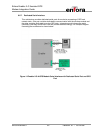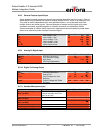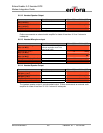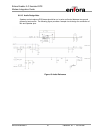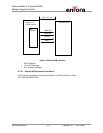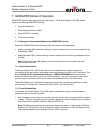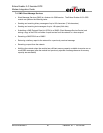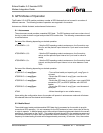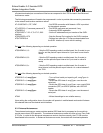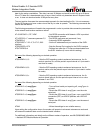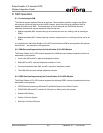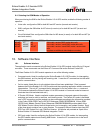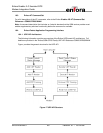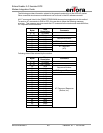
Enfora Enabler II-G Assisted GPS
Modem Integration Guide
8. GPS Modes of Operation
The Enabler II-G A-GPS module provides a number of GPS features that can be used in a number of
different manners. The following modes of operation are supported in the module:
Autonomous, Mobile Assisted, and enhanced Autonomous
8.1. Autonomous
The autonomous mode provides unassisted GPS data. The GPS antenna must have a clear view of
the sky in order to obtain a signal and provide GPS location data. The following commands are used
to set the feature:
Set
one of the following depending on desired operation:
AT$GOPMD=1,1,0 - Sets the GPS operating mode to autonomous, the fix mode to one-
time fix, and the periodic report interval to 0 (not used in one-time fix
mode)
AT$GOPMD=1,2,0 - Sets the GPS operating mode to autonomous, the fix mode to
native, and the periodic report interval to 0 (not used in native fix
mode)
AT$GOPMD=1,3,x - Sets the GPS operating mode to autonomous, the fix mode to timed
interval, and the periodic report interval x to a value between 2 and
7200.
Set
one of the following depending on desired operation:
AT$GPSLCL=0,<msgType> - Turns all local serial port reporting off, <msgType> is
not used
AT$GPSLCL=1,<msgType> - Directs the GPS data of <msgType> over the main
serial port
AT$GPSLCL=2,<msgType> - Directs the GPS data of <msgType> over a serial DUN
connection (PPP) as UDP/IP packets, with UDP-API
header
AT$GPSLCL=5,<msgType> - Directs the GPS data of <msgType> over the second
serial port
AT&W - Writes the settings to non-volatile memory
Upon setting the configuration above, the modem will operate in autonomous mode and will stream
the selected data over the desired serial interface.
8.2. Mobile Based
The mobile-based mode provides assisted GPS data that is processed on the module to provide
more robust GPS operation. It is not necessary for the GPS antenna to have a clear view of the sky
in order to operate. In Mobile based mode, the module will download ephemeris data for the current
satellites in view based on the Cell ID. The module will send the cell ID to the assistance server and
the assistance server will return back the ephemeris data for satellites in view for those cell IDs. The
frequency for downloading this data will be approximately once every 30 minutes. Also, the number
MLG0208PB001 42 Version1.01 – 10/3/2006



